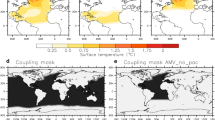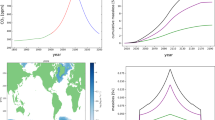Abstract
On the time scale of a century, the Atlantic thermohaline circulation (THC) is sensitive to the global surface salinity distribution. The advection of salinity toward the deep convection sites of the North Atlantic is one of the driving mechanisms for the THC. There is both a northward and a southward contributions. The northward salinity advection (Nsa) is related to the evaporation in the subtropics, and contributes to increased salinity in the convection sites. The southward salinity advection (Ssa) is related to the Arctic freshwater forcing and tends on the contrary to diminish salinity in the convection sites. The THC changes results from a delicate balance between these opposing mechanisms. In this study we evaluate these two effects using the IPSL-CM4 ocean-atmosphere-sea-ice coupled model (used for IPCC AR4). Perturbation experiments have been integrated for 100 years under modern insolation and trace gases. River runoff and evaporation minus precipitation are successively set to zero for the ocean during the coupling procedure. This allows the effect of processes Nsa and Ssa to be estimated with their specific time scales. It is shown that the convection sites in the North Atlantic exhibit various sensitivities to these processes. The Labrador Sea exhibits a dominant sensitivity to local forcing and Ssa with a typical time scale of 10 years, whereas the Irminger Sea is mostly sensitive to Nsa with a 15 year time scale. The GIN Seas respond to both effects with a time scale of 10 years for Ssa and 20 years for Nsa. It is concluded that, in the IPSL-CM4, the global freshwater forcing damps the THC on centennial time scales.













Similar content being viewed by others
References
Blanke B, Delecluse P (1993) Variability of the tropical Atlantic ocean simulated by a general circulation model with two different mixed layer physics. J Phys Oceanogr 23:1363–1388
de Boyer Montégut C, Madec G, Fischer AS, Lazar A, Iudicone D (2004) Mixed layer depth over the global ocean: an examination of profile data and a profile-based climatology. J Geophys Res 109:C12003
Broecker WS (1991) The great conveyor belt. Oceanography 4:79–89
Dickson RR, Brown R (1994) The production of North Atlantic deep-water—sources, rates and pathways. J Geophys Res 12:319–341
Dixon KW, Delworth TL, Spelman MJ, Stouffer RJ (1999) The influence of transient surface fluxes on North Atlantic overturning in a coupled gcm climate change experiment. Geophys Res Lett 26:2749–2752
Fichefet T, Morales Maqueda MA (1997) Sensitivity of a global sea ice model to the treatment of ice thermodynamics and dynamics. J Geophys Res 102:12609–12646
Ganachaud A, Wunsch C (2000) Improved estimates of global ocean circulation, heat transport and mixing from hydrographic data. Nature 408:453–457
Gent PR, Mc Williams JC (1990) Isopycnal mixing in ocean circulation models. J Phys Oceanogr 20:150–155
Goosse H, Fichefet T (1999) Importance of ice–ocean interactions for the global ocean circulation: a model study. J Phys Oceanogr 23:337–355
Hu AX, Meehl GA, Washington WM, Dai AG (2004) Response of the Atlantic thermohaline circulation to increased atmospheric CO2 in a coupled model. J Clim 17:4267–4279
Intergovernmental Panel on Climate Change (IPCC) (2001) Third assessment report of climate change, chapter 8. Cambridge University Press, London
Krinner G, Viovy N, de Noblet-Ducoudre N, Ogee J, Polcher J, Friedlingstein P, Ciais P, Sitch S, Prentice IC (2005) A dynamic global vegetation model for studies of the coupled atmosphere–biosphere system. Global Biogeochem Cycles 19:GB1015
Kwok R, Cunningham GF, Pang SS (2004) Fram Strait sea ice outflow. J Geophys Res 109:1029–1043
Latif M, Roeckner E, Mikolajewicz U, Voss R (2000) Tropical stabilisation of the thermohaline circulation in a greenhouse warming simulation. J Clim 13:1809–1813
Levitus S (1982) Climatological atlas of the world ocean. Professional paper, NOAA/GFDL
Li ZX (1999) Ensemble atmospheric GCM simulation of climate interannual variability from 1979 to 1994. J Clim 12:986–1001
Lohmann G (2003) Atmospheric and oceanic freshwater transport during weak atlantic overturning circulation. Tellus 55A:438–449
Madec G, Delecluse P, Imbard M, Lévy C (1998) OPA version 8. Ocean general circulation model reference manual. Rapp. Int., LODYC, France, 200 pp
Manabe S, Stouffer RJ (1999) The role of thermohaline circulation in climate. Tellus 51:91–109
Marti O, Braconnot P, Bellier J, Benshila R, Bony S, Brockmann P, Cadule P, Caubel A, Denvil S, Dufresne JL, Fairhead L, Filiberti M-A, Foujols M-A, Fichefet T, Friedlingstein P, Grandpeix J-Y, Hourdin F, Krinner G, Lévy C, Madec G, Musat I, de Noblet N, Polcher J, Talandier C (2005) The new IPSL climate system model: IPSL-CM4. Note du pôle de modélisation n°26. ISSN 1288-1619, 88 pp, http://www.dods.ipsl.jussieu.fr/omamce/IPSLCM4/DocIPSLCM4/
Mikolajewicz U, Voss R (2000) The role of the individual air-sea flux components in CO2-induced changes of the ocean’s circulation and climate. Clim Dyn 16:627–642
Neelin JD, Dijkstra HA (1995) Coupled ocean–atmosphere interaction and the tropical climatology, part I: The dangers of flux-correction. J Clim 8:1343–1359
Pickart RS, Spall MA, Ribergaard MH, Moore GWK, Milliff RF (2003) Deep convection in the Irminger Sea forced by the Greenland tip jet. Nature 424:152–156
Rahmstorf S, Ganopolski A (1999) Long-term global warming scenarios computed with an efficient coupled climate model. Clim Change 43:353–367
Roullet G, Madec G (2000) Salt conservation, free surface and varying levels: a new formulation for ocean general circulation models. J Geophys Res 23:927–942
Saenko OA, Gregory JM, Weaver AJ, Eby M (2002) Distinguishing the influence of heat, freshwater, and momentum fluxes on ocean circulation and climate. J Clim 15:3686–3697
da Silva AM, Young CC, Levitus S (1994) Atlas of surface marine data 1994. Anomalies of miscellaneous derived quantities, vol 5. NOAA Atlas NESDIS 10. US Department of Commerce, NOAA, NESDIS
Speer K, Tziperman E (1992) Rates of water mass formation in the North Atlantic Ocean. J Phys Oceanogr 22:93–104
Stommel H (1961) Thermohaline convection with two stable regimes of flow. Tellus 13:224–230
Stouffer RJ et al. (2006) Investigating the causes of the response of the thermohaline circulation to past and future climate changes. J Clim 19:1365–1387
Stouffer RJ, Manabe S (2003) Equilibrium response of thermohaline circulation to large changes in atmospheric CO2 concentration. Clim Dyn 20:759–773
Tziperman E (1986) On the role of interior mixing and air–sea fluxes in determining the stratification and circulation of the ocean. J Phys Oceanogr 16:680–693
Tziperman E (2000) Uncertainties in thermohaline circulation response to greenhouse warming. Geophys Res Let 27:3077–3080
Uppala SM et al (2005) The ERA-40 re-analysis. Q J R Meteorol Soc 131:2961–3012
Valcke S, Declat D, Redler R, Ritzdorf H, Schoenemeyer T, Vogelsang R (1004) Proceedings of the 6th international meeting. High performance computing for computational science, vol 1. Universidad Politecnica de Valencia, Valencia, Spain. The PRISM coupling and I/O system. VECPAR’04
Vellinga M, Wood RA, Gregory JM (2002) Processes governing the recovery of a perturbed thermohaline circulation in HadCM3. J Clim 15:764–780
Walin G (1982) On the relation between sea-surface heat flow and thermal circulation in the ocean. Tellus 34:187–195
Wijffels SE, Schmitt RW, Bryden HL, Stigebrandt A (1992) Transport of freshwater by the oceans. J Phys Oceanogr 22:155–162
Williams P, Guilyardi E, Sutton R, Gregory J, Madec G (2006) Tropical Pacific ocean adjustment to changes in the hydrological cycle in a coupled ocean–atmosphere model. Clim Dyn (in press)
Wood RA, Keen AB, Mitchell JFB, Gregory JM (1999) Changing spatial structure of the thermohaline circulation in response to atmospheric CO2 forcing in a climate model. Nature 399:572–575
Acknowledgments
Stimulating discussions with Gurvan Madec, Paul Williams, Didier Paillard and Gilles Ramstein are acknowledged. We are indebted to Clément de Boyer Montégut for providing data of mixed layer depth climatology and for enriching suggestions. Patrick Brockman kindly provided advice on the Ferret graphics package and its extension FAST. The coupled simulations were carried out on the NEC SX6 of the Centre de Calcul de Recherche et Technologie (CCRT). This work was supported by the Commissariat à l’Energie Atomique (CEA), and the Centre National de la Recherche Scientifique (CNRS)
Author information
Authors and Affiliations
Corresponding author
Rights and permissions
About this article
Cite this article
Swingedouw, D., Braconnot, P., Delecluse, P. et al. The impact of global freshwater forcing on the thermohaline circulation: adjustment of North Atlantic convection sites in a CGCM. Clim Dyn 28, 291–305 (2007). https://doi.org/10.1007/s00382-006-0171-3
Received:
Accepted:
Published:
Issue Date:
DOI: https://doi.org/10.1007/s00382-006-0171-3




